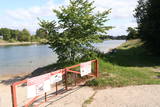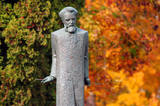| Nr | Name | Beschreibung |
|---|---|---|
|
Der Kanal der Karaosta und die in diesem Objekt gelegene Station der Seeflote und U-Boot Station wurden auf Befehl der Zar Rußlands vor dem ersten Weltkrieg ausgegraben. Heutzutage ist der Hafen der Unterseeboote ein geschlossenes Territorium und er wird zum wirtschaftlichen Zweck genutzt. Der Kanal von Karaosta ist von der Seite der Pulvera Straße aus, als auch von der Seite der Klapaka Brücke aus zu sehen.
|
||
|
Die Wirtschaft Lazdiņi ist eine der modernsten Wirtschaften in Lettland, sie befindet sich am nordwestlichen Teil des Flachlandes der Region Zemgale, in der Gemeinde Krimūnas. Die Wirtschaft hat sich auf die Züchtung (ungefähr 1100 ha), Aufbereitung und Aufbewahrung von Getreidepflanzen spezialisiert. Der Wirt Juris Lazdiņš ist der Leiter der größten nicht staatlichen Organisation für Landwirte in Lettland. Mit vorheriger Anmeldung können erfahrene und neue Fachleute der Landwirtschaft die Wirtschaft besuchen, um Erfahrung zu teilen. In der Umgebung breitet sich Flachland aus, das eine typische Landschaft der Region Zemgale ist. |
||
|
Wurde für den Schutz der Inselgruppe Vilsandi (ung. 100 kleine Inseln) gegründet. Die größte ist 6 km lange un bis 2 km breite Vilsandi Insel. |
||
|
Im Dorf Kaldabruna im Bezirk Jekabpils hat sich in den Räumen des Wirtschaftsgebäudes der ehemaligen Schule Kaldabruna jetzt die Gesellschaft „Ūdenszīmes“ („Wasserzeichen“) niedergelassen. Hier wurde ein bis dato in Lettland nicht gesehener Ort für Kunst eröffnet: die Galerie in der Scheune. Im Wiesenmuseum ist die Ausstellung im Sinne eines in der Folklore häufig zu findenden Gleichnisses gestaltet, indem man sich auf Lebensabschnitte von Menschen bezieht, sehen Sie hier eine Exposition von Gräsern, von Lichtobjekten der Kindheit, den Gürtel der Kaldabruner Mara in einer hohlen Eiche, Zauberkranz, Mitgiftkranz, geschützte und seltene Pflanzen. Der Gürtel der Mara von Kaldabruna bzw. Mara Krievane ist eines der bedeutendsten kulturellen und historischen Objekte der Region, ein einzigartiges ethnographisches Zeugnis. Die Symbolik des Gürtels besteht aus 52 Elementen von denen 36 Variationen der Swastika (des traditionellen Feuersymbols) sind; gleichwertiges Material gibt es de facto nicht in der lettischen Ethnographie, am ehesten vergleichbar wäre das große Wolltuch aus Stameriena, auf dem 19 verschieden Varianten zu finden sind. Der Gürtel ist im Prinzip wie ein Zopf geflochten bestehend aus gelben und blauen Mustern, wobei an den Rändern noch rot und grün verwendet werden, die Enden sind teils kompliziert mit Perlen und Quasten besetzt. Bisher gab es keine authentische Kopie, die der Öffentlichkeit zugänglich gewesen wäre. Auch im digitalen Raum war dieses Einzelstück nicht einsehbar. Das Original des Gürtels wurde Ende des 19. Jh. von Māra Krievāne aus dem Hof „Mačulāni“ in Kaldabruna an Volkskundler übergeben worden und gelangte in das Lettische Geschichtsmuseum, wo man auch die einzige bisher bekannte authentische Kopie besichtigen kann. Die Erläuterung der Symbolik finden man im Buch „Latvju Raksti“ („Lettische Symbole“). |
||
|
1935. gadā Tūjā darbojās ķieģeļu ceplis, kas
ražošanā izmantoja apkārtnē esošās Devona perioda mālu iegulas.
1936. gadā uzsāka jaunās fabrikas celtniecību. Šeit ražoja arī augstas
kvalitātes ķieģeļus, ar kuriem tika apšūts arī Rīgas Pulvertornis. Tagad
fabrikas vietā ir pamests grausts, kas redzams no Tūjas centra, ejot jūras
virzienā.
|
||
|
Atrodas Kraujā – Daugavas ielejas krasta malā un nogāzēs. Atrodama informācija, ka šajā vietā Livonijas kara laikā atradusies krievu karaspēka nometne. Muižas nosaukums cēlies no vācu Hof zum Berg – „Kalnu muiža”. Pēdējie muižas īpašnieki līdz 1. pasaules karam bija grāfu Šahno dzimtas pārstāvji. Viens no tiem – Marians Šahno 1910. gadā uzceļ muižas pili, kas bija būvēta eklektisma formās. Daļēji nojaukta tā pārdzīvo padomju laikus, līdz 2002. gadā nodeg. Līdz mūsdienām saglabājušās vien ēkas sienas, kuras slēpj biezs augājs. Var tikai iedomāties, kādi skati šeit kādreiz pavērušies uz Daugavas ieleju! Muižas parks ir vietējo iedzīvotāju pastaigu vieta. |
||
|
Atrodas 4,5 km ziemeļos no Rīgas – Daugavpils šosejas (A 6), klajā laukā (ap 3 m augsts, ainavisks). Viens no izcilākajiem Latvijas muldakmeņiem, tādēļ ir vērts izmest kādu loku. Akmens augšdaļā ir iekalts gandrīz 2 m garš un ~ 20 cm dziļš muldveida iedobums. Atrodamas ziņas, ka vēl 19. gs. vidū pie akmens ir ziedots ēdiens, monētas u.c. priekšmeti. Pie tā dedzināti ugunskuri un svinēti svētki. Teikas vēsta, ka velns muldā lējis ūdeni un gribējis mīcīt mīklu, kā arī parāvis zem akmens tuvējo māju saimnieku. |
||
|
Im Jahr 2005 wurde ein Stegpfad angelegt, über den man vom Haus Dunte (Münchhausenmuseum) durch die feuchten Küstenwälder bis zur Küste spazieren kann. Entlang des Pfades wurden Erholungsplätze mit Holzskulpturen und Spielen nach dem berühmten Baron Münchhausen geschaffen.
|
||
|
Kuģīša piestātne atrodas Ostas ielas malā, kur tai piekļaujas Tirgus iela. „Hercogs Jēkabs” ekskursantus izvizina 45 minūšu garā braucienā (no maija – oktobrim) pa Ventas grīvu, piedāvājot aplūkot Ventspils ostas un vecpilsētas ainavas no citiem skatu punktiem. |
||
|
Das Gästehaus befindet sich an dem Ufer des Urstromtales des Flusses Amata. Das Gebäude ist aus natürlichen Materialien (aus den örtlichen Dolomitblöcken) gebaut worden. Hier werden Bio-Speisen angeboten: im Bio-Humus gezüchtete Kartoffeln, Waldbeeren, Waldpilze, ländliche Produkte und grüne Kräuter aus dem eigenen Garten. Lettische Küche: Gebratene und gegrillte Forellen, Rindfleischsteak, Steinpilz- und Pfifferlingsoße. Das besondere Gericht: Der puffige Kuchen von Eglaine aus Bio-Eiern und Kuchen aus Pekannüssen mit Eis. |
||
|
This park is in a region of hillocks in the Karula highlands, and Lake Ähijärve is at its centre. The park offers a cultural environment of small farms, and it was set up to protect the unique cupola-shaped hillocks of the area. Main attractions: Scenic Lake Ähijärv (176ha), Rebasemõisa Tornimägi hill (137.8 m above sea level), undulating landscapes. |
||
|
In Limbaži, an der Kreuzung der Straßen Cēsu und Dailes befindet sich ein Denkmal für den Autor der Nationalhymne Lettlands. Die Autoren des Denkmals sind die Bildhauer Z. Rapa und J. Rapa. Das Denkmal wurde am 16. Mai 1998 eröffnet, zum 775-Jubiläum der Stadt Limbaži. |
||
|
Auf diesem Bauernhof werden Thüringer Ziegen gezüchtet und Ziegenmilchkäse sowie verschiedene Leckerbissen hergestellt. Zudem werden hier auch Gewürz- und Heilpflanzen angebaut, die für Tees und Naturkosmetik benutzt werden. |
||
|
Vilsandi bāka sāka darboties 1809. g. Ja uzmanīgi palūkojas uz torņa, labi redzams, ka tas ir vairākas reizes paaugstināts. Tagadējās bākas augstums ir 37 m, bet gaismas elements atrodas 40 metrus virs jūras līmeņa. Bāka ar apkārtējām ēkām ir apskatāma tikai no ārpuses. Ja pa Vilsandi arhipelāgu ceļo ar jūras laivu vai citu peldlīdzekli, tad bāka kalpo kā ļoti labs orientieris daudzo salu, līču un pussalu labirintā. No bākas redzama jūras krastā uzceltā glābšanas stacija. Pateicoties tai, Vilsandi ūdeņos izglābti 29 cilvēki, 2 suņi un 1 kaķis. Tā stāsta vietējie. |
||
|
Diese Straße ist eine der einzigartigsten historischen Sehenswürdigkeiten des Dorfes Bigauņciems. Die Straße beginnt an der Küste, setzt sich als eine Straße mit demselben Namen fort, überquert den Fluss Vecslocene (hier gibt es keine Brücke, aber Fußgänger und Radfahrer können den Fluss überqueren) und schlängelt sich als ein Waldweg bis zum See Melnezers. |
||
|
Also known as Lake Jēsis or Lake Iesis, this is the lake in Latvia which has the largest number of islands. Many literary sources and encyclopaedias in the 20th century claimed that there were 69 islands in the lake, but that was an exaggeration, because apparently the authors took sandbars overgrown with reeds and other plants to be islands. The true number is approximately two times lesser. The largest number of islands can be found in the north-eastern part of the lake. The largest one is Lielā Lāča (Big Bear) Island (45 ha). A farm was on the island at one time. The islands and the oak trees that are on the shores of the lake – the Piļoru and Pahatnīku stands of trees – are in a restricted environmental reserve. |
||
|
Ein ethnographisches Gästehaus auf der Insel Muhu, in der historischen Siedlung Paenese. |
||
|
The spoon workshop offers useful objects such as wooden spoons, cutting boards, butter knives, pans, spatulas, etc. You can produce your own wooden spoon and look at finished spoons made of more than 17 different types of wood from Latvia. During the summer the owners offer “pancake tours” with tasty jams. You can purchase spoons and homemade wine. |
||
|
Das Café befindet sich im Zentrum von Aglona an der Straße nach Dagda (P 60). Lettische Küche: Schweinefleischfrikadellen, Kartoffeln mit Hering und Sauerrahm, Quarkcreme mit Erdbeeren. Das besondere Gericht: Rouladen. |
||
|
Ein auf dem südostlichen Teil des Dombergs 1808 – 1810 gebautes Gebäude nennt man Wissenschaftsperle. Im Observatorium ist ein attraktives Museum eingerichtet. |
||



















